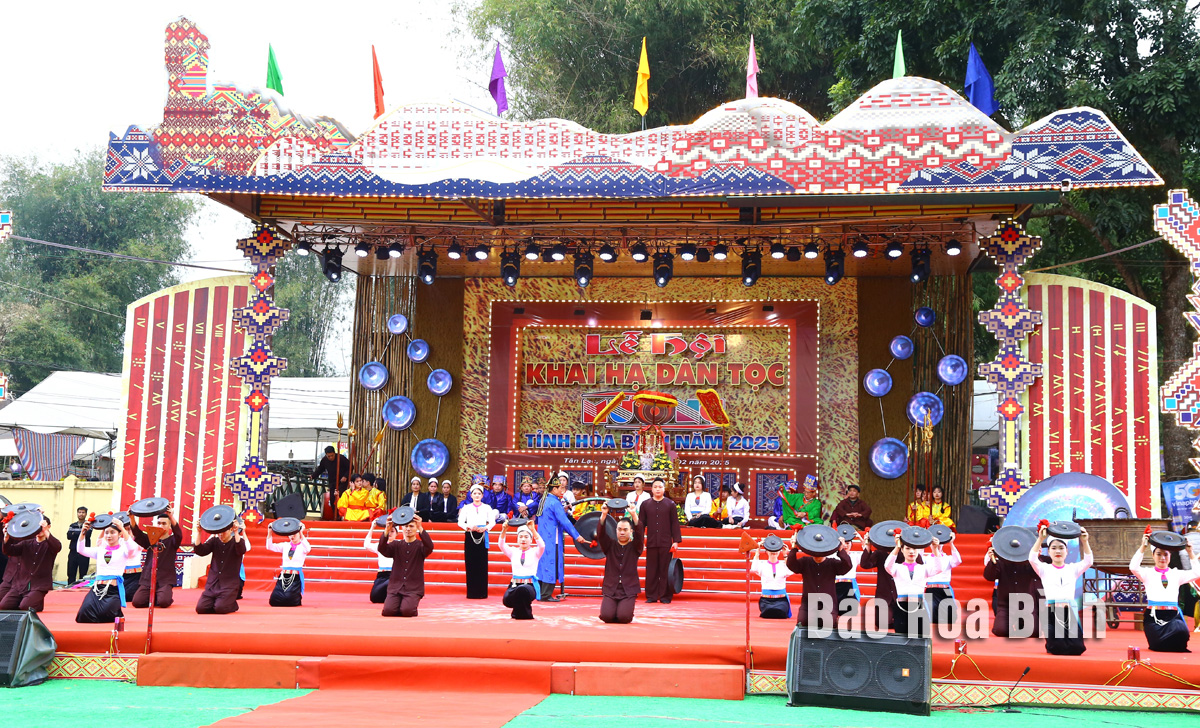
Hoa Binh province has harnessed its rich cultural heritage and human potential to forge the path towards sustainable development in the new era.
The
Khai ha (going down to the field) festival of the Muong ethnic group is held
annually to promote local cultural values.
The province is home to six main ethnic groups,
with the Muong people making up over 63% of the population. Each group
contributes distinctive cultural elements that create a diverse tapestry of
traditions. The locality boasts a long-standing historical and cultural values
with an array of festivals such as Tien Pagoda, Khai ha, Bo Temple, and Xen
Muong.
Besides, the province boasts the world-renowned
Hoa Binh Civilisation that dates back to prehistoric times, along with the four
major Muong regions of Bi, Vang, Thang, and Dong. Standing as a cradle of the
Vietnamese culture, Hoa Binh is now preserving hundreds of bronze drums and
nearly 10,000 precious gongs.
Seeing culture as a motivation for sustainable
development, the province has carried out various measures promote the values
of the Muong ethnic culture and the Hoa Binh Civilisation. It has emphasised
the people as both the centre and goal of development. Given this, the
provincial Party Committee has launched multiple action programmes to cultivate
locals’ ethics, lifestyle, and patriotism. The hardworking, compassionate, and
creative people of Hoa Binh have become the nucleus of all development policies
and also a bridge linking traditional values with the modern time.
According to Director of the provincial
Department of Culture, Sports and Tourism Quach Thi Kieu, Hoa Binh province has
paid due attention to preserving and promoting traditional cultural values. It
is home to 41 national heritage sites, 71 provincially ranked sites, and 303
protected historic and scenic locations. Additionally, 786 elements of
intangible cultural heritage from five ethnic minority groups – Muong, Thai,
Tay, Dao, and Mong – have been documented. One site has achieved special
national relic site status, while five intangible cultural elements have
received national recognition. In particular, a dossier has been compiled to
seek UNESCO's inclusion of the Mo Muong cultural heritage in the list of
heritage in need of urgent safeguarding.
Provincial authorities have implemented
strategic campaigns to attract socio-economic investment while preserving
cultural heritage through Resolution 04-NQ/TU, issued bythe provincial
Party Committee's Standing Board in October 2021, which outlines the
preservation and promotion of local ethnic groups' cultural heritage values for
2021–2025, with a vision to 2030.
The province has also activelypromoted
creativity among the public, resulting in numerous artistic works and cultural
programmes. Notably, it has worked to enhance cultural preservation in tandem
with tourism development. Tan Lac, Mai Chau, and Lac Son districts have become
popular destinations as they are able to capitalise on ethnic culture.
Hoa Binh is advancing by utilising its soft
power – cultural and human assets. Culture has become a strategic force driving
economic development, social stability, and improved living quality for local
residents.
When requesting personal document verification and certification service at the one-stop-shop service section of Dong Tam Commune in Lac Thuy district, Nguyen Thanh Long, a resident of Dong Bong village, was both surprised and pleased with the professionalism and attitude of civil servants working there.
In Hoa Binh province, 11 traditional craft villages with more than 400 small-scaled production households have put in place a clean and green production model, establishing new standards for sustainable development. Waste collection sites and wastewater treatment facilities have been meticulously managed by local residents.
To make it easier for the residents to handle administrative procedures, Yen Bong Commune (Lac Thuy District) has identified the administrative reform as one of its key tasks. By implementing a range of synchronized solutions, the commune has seen the positive changes in the administrative reform, meeting the needs of its people.
Mai Chau district has firmly established itself as a standout destination on Vietnam’s tourism map, attracting both domestic and international visitors with its breathtaking landscapes, rich ethnic culture, and warm hospitality. However, beyond its natural and cultural charm, a secure and well-managed tourism environment has added to Mai Chau’s appeal.
As Vietnam enters a new phase of economic and administrative reform in 2025, Hoa Binh province is stepping up its efforts to streamline governance, boost economic growth, and attract investment.
The Hoa Binh provincial People's Committee held its monthly meeting on March 26 to review the progress of key projects, assess budget revenue and public investment disbursement, provide feedback on draft documents for submission to the provincial Party Committee's Standing Board, and discuss other important matters related to the committee's governance activities.



